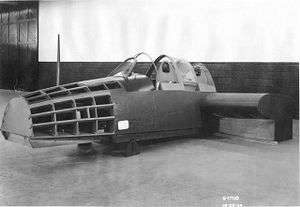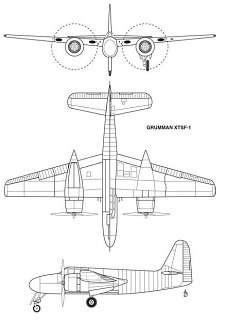Grumman XTSF
| XTSF | |
|---|---|
 | |
| Mockup of the XTSF-1's forward fuselage | |
| Role | Torpedo scout |
| Manufacturer | Grumman |
| Primary user | United States Navy |
| Number built | None |
| Developed from | F7F Tigercat |
The Grumman XTSF was a proposed twin-engine torpedo scout aircraft, designed by Grumman for the United States Navy towards the end of World War II. Based on the design of the Grumman F7F Tigercat fighter, enlarged and with the addition of a bomb bay, the XTSF was deemed too large for carrier operations, and the project was cancelled before any aircraft were built. Instead, the Navy chose to order the single-engine XTB3F, which became the successful AF Guardian.[1]
Design and development
In 1944, it was determined that the Grumman XTB2F, then under development for the Navy, would be too large to practically and safely operate from aircraft carriers.[1] Even the new Midway-class aircraft carriers, known as "battle carriers" (CVB) and the largest aircraft carriers built by any nation to that point, would have difficulty operating the massive aircraft, which was the size of a U.S. Army Air Force medium bomber.[2] As a result, in late June 1944, Grumman submitted its G-66 design to the Bureau of Aeronautics (BuAer).[2] After a review of the design by BuAer during the following month, a revised design was submitted, and on August 17 the existing contract for the XTB2F was modified to instead order two XTSF-1 aircraft,[2] to be based on Grumman's F7F-2 Tigercat two-seat, twin-engined fighter-bomber, the first prototype intended to be a conversion of a F7F airframe.[3]
A mid-wing, all-metal, cantilever monoplane with two Pratt & Whitney Double Wasp radial engines mounted in streamlined nacelles under the wing,[4] the XTSF-1 was intended to carry two crew members in tandem seats, and featured an internal bomb bay and a SCR-720 radar set, the radar later being replaced in the design by an AN/APS-3 or AN/APS-4 set.[2] A second seat was added for the radar operator.[2]
The outer wing of the XTSF was lengthened by 7.8 feet (2.4 m) compared to that of the F7F-2, while the size of the horizontal stabilizer was increased by 28 inches (71 cm)).[2] The vertical stabilizer was also enlarged, while the aircraft's weight increased by almost two thousand pounds (900 kg) over that of the Tigercat.[2]
The wings folded upwards for stowage aboard aircraft carriers, while the undercarriage and arrestor hook were hydraulically operated.[4] Gun armament was planned to be four .50 caliber (12.7 mm) Browning M2 machine guns,[5] or, alternatively, two 20 mm Hispano cannon,[2] while a bomb bay based on that of the Grumman TBF Avenger was installed in a fuselage stretched by 5.5 inches (14 cm).[2]
Cancellation
A mockup of the cockpit, center fuselage and wing center section was built and was inspected by the BuAer in the fall 1944.[6] However, the contract for the prototype XTSF-1s was terminated in January 1945. This was due to a variety of factors, including the Navy's belief that the Grumman engineers and factory were already at capacity producing the F6F Hellcat, the F7F, and the F8F Bearcat,[7] that the XTSF-1 would be too large for practical operations from escort carriers,[2] and because it was believed the Grumman G-70, to be built as the XTB3F, was a better prospect.[1] In addition, the F7F was proving difficult to certify for operations from aircraft carriers,[8] further prejudicing the Navy against the design.
Some sources erroneously state that the XTSF-1 became the XTB2F,[9] however this is not the case.[2] The XTSF-1 was the only aircraft ever designated by the U.S. Navy in the 'TS for Torpedo Scout' category,[6] the designation being superseded and incorporated, along with 'BT for Bomber-Torpedo', 'SB for Scout-Bomber' and 'TB for Torpedo-Bomber', into the new 'A for Attack' series.[10]
Specifications (XTSF-1)

Data from [5]
General characteristics
- Crew: 2 (Pilot and radar operator)
- Length: 46 ft 4 in (14.12 m)
- Wingspan: 59 ft 4 in (18.08 m) (folded span 32 feet (9.8 m))
- Height: 16 ft (4.9 m)
- Wing area: 500 sq ft (46 m2)
- Airfoil: NACA 23015-23012
- Empty weight: 17,288 lb (7,842 kg)
- Gross weight: 26,171 lb (11,871 kg)
- Fuel capacity: 400 US gallons (1,500 l; 330 imp gal)
- Powerplant: 2 × Pratt & Whitney R-2800-22W Double Wasp radial engines, 2,400 hp (1,800 kW) each
- Propellers: 4-bladed Aeroproducts H-20-156, 13 ft 2 in (4.01 m) diameter
Performance
- Maximum speed: 414 mph (666 km/h; 360 kn) at 18,600 feet (5,700 m)
- Stall speed: 84 mph (73 kn; 135 km/h)
- Range: 975 mi (847 nmi; 1,569 km) internal fuel at 172 miles per hour (277 km/h)
- Combat range: 395 mi (343 nmi; 636 km) radius with two 150 US gallons (570 l; 120 imp gal) drop tanks
- Service ceiling: 36,500 ft (11,125 m)
- Rate of climb: 3,920 ft/min (19.9 m/s)
- Wing loading: 47.9 lb/sq ft (234 kg/m2)
- Power/mass: 6.5lb/bhp
Armament
- Guns: 4 .50-calibre machine guns
- Hardpoints: Two, 1,000 pounds (450 kg) capacity each
- Bombs: Internal bomb bay, capacity one Mark 13 torpedo, one 2,000 pounds (910 kg) bomb or naval mine, or up to 4,000 pounds (1,800 kg) smaller bombs, or up to 1,300 pounds (590 kg) depth charges.
See also
- Related development
- Aircraft of comparable role, configuration and era
- Related lists
References
Citations
- 1 2 3 Goebel 2009
- 1 2 3 4 5 6 7 8 9 10 11 Norton 2008, p. 120
- ↑ American Aviation Historical Society Journal, v.14-15, p. 269.
- 1 2 Angelucci 1987, p. 238.
- 1 2 Johnson 2008, p. 427
- ↑ Norton 2008, p. 121
- ↑ Meyer 2002, p. 55
- ↑ Lawson and Tillman 2001, p. 87
- ↑ "U.S. Systems of Aircraft Designation", driko.org. Accessed May 8, 2010.
Bibliography
- Angellucci, Enzo (1987). The American Fighter from 1917 to the Present. New York: Orion. ISBN 0-517-56588-9.
- Goebel, Greg (2009). "The Grumman AF Guardian". vectorsite.net. Retrieved 2010-05-06.
- Johnson, E.R. (2008). American Attack Aircraft Since 1926. Jefferson, NC: McFarland & Company. ISBN 9780786434640.
- Lawson, Robert; Barrett Tillman (2001). U. S. Navy Dive and Torpedo Bombers of World War II. St. Paul, MN: MBI Publishing. ISBN 0-7603-0959-0.
- Meyer, Corwin H. (August 2002). "F7F Tigercat: The Untold Story". Flight Journal. Ridgefield, CT: AirAge Publications.
- Norton, Bill (2008). U.S. Experimental & Prototype Aircraft Projects: Fighters 1939-1945. North Branch, MN: Specialty Press. ISBN 978-1-58007-109-3.
- U.S. Navy (August 1, 1944). "XTSF-1 Airplane Characteristics and Performance" (PDF). alternatewars.com. Retrieved 2011-01-08.
External links
- U.S. Navy (July 1944). "Aircraft Description Card for XTSF-1" (PDF). alternatewars.com. Retrieved 2011-01-08.
- "Grumman Designs and Proposals", The Grumman Pages.
- TS - Torpedo Scout Aircraft, U.S. Military Aircraft and Weapon Designations